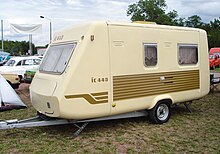Intercamp
From 1975 to the end of the 1980s, caravans under the name Intercamp (IC) were manufactured in Georgewitz-Bellwitz in Oberlausitz . The Intercamp was primarily developed to sell in the so-called “non-socialist economic area” (NSW) . He should bring the GDR the rare foreign currency . The distribution in the Federal Republic took place through the Fritz Berger company in Neumarkt under the name Berger Oase . The IC 440 is said to have cost around 9,000 D-Marks, depending on the equipment. ICs were also sold in the Netherlands . In the GDR itself, Intercamps were also sold (with waiting time), but in simpler versions (no refrigerator, simpler or no heating , cooker-sink combination made of plastic, sometimes made of steel enamel instead of stainless steel ) as well as "returns" from the FRG, the were not accepted by the Fritz Berger company due to quality and at relatively high prices. An IC 440 is said to have cost 42,705 DDR marks, an IC 355: 15,000. Another way to get an IC without waiting was the DDR-GENEX gift shop . Both models (in the simpler versions) were offered in various catalogs for around 14,250 Deutschmarks. In addition to the models mentioned, there were a number of prototypes that were never put into series production. Like the series models, these had bodies made of fiberglass-reinforced plastic with polyurethane insulation and were larger than the series-produced models.
Versions
There were essentially two models with different detailed designs: the Intercamp (IC) 355 and the IC 440. These two models differ mainly in their length of 3.55 m and 4.40 m respectively. This resulted in different designs of the interior.
There was the IC 355 L and (later in parallel) the IC 355 LB. The IC 355 L has sleeping options in the bow and stern that can be converted into seating groups, a kitchen on the left-hand side in the direction of travel and a wardrobe on the right-hand side. In some versions here a heater (Solar 3000 from GDR production or Trumatic 3002 from West German production) was installed in the lower area.
The IC 355 LB had a front kitchen, next to which there was a sanitary room on the left-hand side in the direction of travel. In the rear there was a round seating group that could be converted into a bed area. On the left side in the direction of travel there was a wardrobe, optionally with a heater (Solar 3000 from GDR production or Trumatic 3002 from West German production). On the right side in the direction of travel there was a half-height cupboard, partly equipped with a refrigerator.
There were also essentially two body versions of the IC 440: the IC 440 N and the IC 440 T. Both versions have a seating area in the front as well as in the rear that can be converted into a sleeping area.
The IC 440 T has a wardrobe on the left (lower area partly a heater (Solar 3000 from GDR production or Trumatic 3002 from West German production)) and a sanitary room. Opposite is the kitchen, consisting of a sink, two-burner propane gas stove and an upper and lower cabinet, the latter partly being equipped with a refrigerator.
In contrast to the IC 440 T, the IC 440 N had a kitchen on the left-hand side and a wardrobe (lower area optionally a heater (Solar 3000 from GDR production or Trumatic 3002 from West German production)) and a half-height cupboard as a “TV -Möbel “.
Other planned models were the IC 400 (an IC 440 shortened at the bow), the IC 460 (at least visually - compared to the IC 355/440 - a new development), the IC 530 (an IC 460 extended by 70 cm) and the IC 600 (an IC 530 again extended by 70 cm with a beveled bow).
Chassis
The IC 355 mostly had chassis from GDR production. These had torsion bar axles with a load capacity of 700 kg or later 800 kg. There were hydraulic overrun brakes in different versions. Some of the IC 355 sold under the name "Oase" in the Federal Republic of Germany had chassis made by Knott or Alko. The IC 440 had chassis made by Alko from the Federal Republic of Germany or chassis from GDR production, which were strongly based on the Alko chassis. Many parts of the axle and the brakes came from the IFA parts shelf and can also be found on the Wartburg 353 or the Barkas B1000 .
The chassis from West German production were galvanized, those from GDR production were mostly just painted black.
construction
A special feature is the outer shell, in which glass fiber reinforced plastic and insulation made of polyurethane were used. This is normally rot-proof, which is an advantage over conventional caravans with a wooden frame.
In the sixties there were caravans with a GRP body in various countries. B. from the Italian company Lander, in the Federal Republic of Schäfer or the Dutch manufacturer Biod .
literature
- Dirk Müller (Hrsg.): Typenkompass - GDR trailer for leisure and business . Motorbuchverlag, 1st edition 2018, ISBN 978-3-613-04070-0 , p. 40-42 .
Web links
- Caravanclub.de - website with forum, which primarily deals with the Intercamp caravans
- Interest group Intercamp Oberlausitz
Individual evidence
- ↑ Intercamp, Oasis and self-made caravan. Retrieved April 6, 2020 .
- ↑ Intercamp, Oasis and self-made caravan. Retrieved March 26, 2020 .
- ↑ Intercamp, Oasis and self-made caravan. Retrieved April 6, 2020 .
- ^ Paul Pietsch Verlage GmbH & Co KG: GDR trailer. Retrieved April 24, 2020 .
- ↑ Genex / Main Catalog / Auto / 1986. Retrieved on March 26, 2020 .
- ^ Interest group Intercamp Oberlausitz. Retrieved April 6, 2020 .
- ↑ http://www.intercamp-oberlausitz.de/
- ↑ Intercamp, Oasis and self-made caravan. Retrieved April 6, 2020 .

